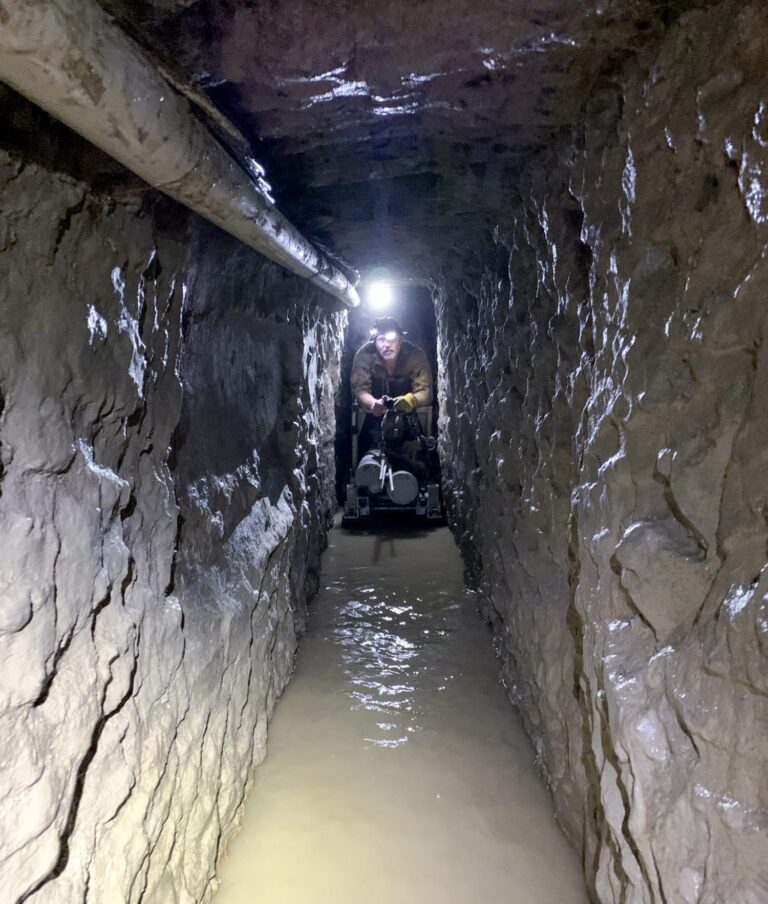U.S. Border Patrol agents have uncovered a highly sophisticated drug smuggling tunnel beneath the San Diego border, marking a significant disruption in the ongoing efforts to combat illicit cross-border trafficking. The tunnel, equipped with advanced features designed to facilitate the covert movement of narcotics, underscores the evolving tactics employed by criminal organizations operating along the U.S.-Mexico frontier. Authorities continue to investigate the site and assess the full extent of the operation, highlighting the persistent challenges faced in securing the border.
Border Patrol Discovers Complex Drug Smuggling Tunnel Beneath San Diego
Border patrol agents have unearthed a highly intricate drug smuggling tunnel extending beneath the San Diego border area, showcasing an alarming level of engineering expertise. The tunnel, equipped with lighting, ventilation, and a rail system, was designed to facilitate the rapid transport of contraband without detection. Authorities described the discovery as one of the most sophisticated and extensive operations they’ve encountered in recent years, highlighting the ongoing challenge in curbing cross-border narcotics trafficking.
This underground passageway features:
- Over 500 feet in length, stretching deep beneath the border
- Electric wiring and ventilation systems ensuring proper airflow
- An advanced rail cart system for swift movement of payloads
- Concealed entrances in residential areas, complicating detection efforts
| Feature | Specification |
|---|---|
| Length | Approx. 530 feet |
| Ventilation | Electric fans and ductwork |
| Lighting | Installed LED fixtures |
| Transport Mechanism | Rail cart system |
Detailed Analysis Reveals Advanced Engineering and Security Features of Tunnel
The tunnel unearthed by Border Patrol agents features state-of-the-art construction techniques, reflecting a high level of engineering expertise. Its walls were reinforced with concrete and steel supports, which not only ensured structural integrity but also allowed for safe passage. Advanced ventilation systems were observed, aimed at maintaining airflow and preventing the buildup of hazardous gases, highlighting the operators’ awareness of underground safety protocols. The use of electrical wiring inside the tunnel, presumably to power lighting and communication devices, further underscores the sophistication of its design.
Security measures within the tunnel demonstrate meticulous planning to evade detection and interception. Motion sensors and remote-controlled hatchways were reportedly integrated, which could alert smugglers to any unauthorized presence. Additionally, the tunnel included concealed trapdoors and escape routes, allowing operatives to navigate rapidly if discovered. Below is a brief overview of the key technical features identified:
| Feature | Description |
|---|---|
| Structural Reinforcement | Concrete lining supported by steel beams |
| Ventilation System | Electric fans with air ducts |
| Electrical Setup | Hardwired lighting and communication |
| Security Mechanisms | Motion detectors and remote hatches |
| Emergency Features | Escape routes and hidden trapdoors |
Implications for Border Security and Law Enforcement Strategies in Southern California
The discovery of the sophisticated tunnel beneath San Diego sharply underscores the evolving tactics employed by drug traffickers along the U.S.-Mexico border. This incident highlights an urgent need for border security agencies to enhance their technological capabilities and collaborative frameworks to effectively detect and neutralize subterranean smuggling operations. The complexity and depth of such tunnels challenge traditional surveillance methods, pushing law enforcement to invest in advanced ground-penetrating radar, seismic sensors, and aerial reconnaissance drones to stay ahead of increasingly inventive smuggling networks.
Law enforcement strategies must also adapt by fostering stronger partnerships between federal, state, and local authorities. Enhanced intelligence-sharing protocols and joint task forces are critical in responding to these clandestine activities swiftly and decisively. Below is a comparison of traditional versus emerging countermeasures currently being prioritized in Southern California:
| Approach | Traditional Methods | Emerging Measures |
|---|---|---|
| Detection | Patrol checkpoints, aerial surveillance | Ground-penetrating radar, seismic sensors, drone monitoring |
| Coordination | Isolated agency efforts | Integrated multi-agency task forces, real-time intelligence sharing |
| Response | Surface operations, manual tunnel inspections | Rapid deployment of specialized tunnel reconnaissance teams and robotic devices |
- Proactive Detection: Monitoring border areas with cutting-edge sensor technology.
- Interagency Cooperation: Streamlining communications across law enforcement bodies.
- Community Engagement: Leveraging local knowledge to identify suspicious activities early.
Ultimately, the success of these evolving strategies hinges on sustained investments and innovation, ensuring Southern California remains equipped to confront this persistent and sophisticated threat.
Recommendations for Enhancing Surveillance and Preventing Future Smuggling Operations
The discovery of the intricate smuggling tunnel beneath San Diego underscores the urgent need for advanced surveillance technologies and enhanced inter-agency collaboration. Investing in state-of-the-art sensors, such as ground-penetrating radar and thermal imaging, can significantly improve early detection efforts. Additionally, expanding the deployment of unmanned aerial vehicles (UAVs) equipped with high-resolution cameras could facilitate real-time monitoring of remote border areas prone to illicit activities.
Key measures to bolster border security include:
- Integrating AI-driven analytics to identify suspicious patterns and predict future smuggling routes.
- Establishing joint task forces combining federal, state, and local law enforcement agencies for rapid response.
- Enhancing community outreach programs to encourage reporting of unusual activities near the border.
- Upgrading physical barriers while maintaining environmental considerations to deter tunnel construction.
| Surveillance Technology | Potential Impact |
|---|---|
| Ground-Penetrating Radar | Detects underground tunnels with high precision |
| Thermal Imaging | Identifies heat signatures from tunnel operations |
| Unmanned Aerial Vehicles | Provides continuous aerial surveillance to cover large areas |
Wrapping Up
The discovery of the sophisticated drug smuggling tunnel under San Diego underscores the ongoing challenges faced by border enforcement agencies in combating illicit cross-border activities. Authorities continue to investigate the scope of the operation and the individuals involved, while reinforcing measures to detect and prevent similar ventures in the future. As the situation develops, officials urge the public to remain vigilant and report any suspicious activity along the border.







